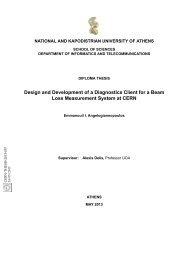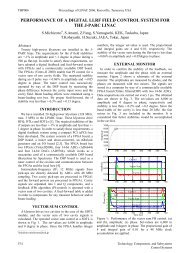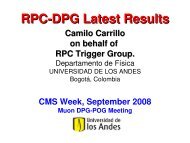Preliminary Ttcbi
Preliminary Ttcbi
Preliminary Ttcbi
Create successful ePaper yourself
Turn your PDF publications into a flip-book with our unique Google optimized e-Paper software.
5.2 OVERALL FEATURES<br />
LHC Project Document No.<br />
LHC-BI-ES-XXXX.XX rev 0.0 Draft<br />
Page 10 of 18<br />
• PMC slave card conforming to the IEEE P1386.1 standard.<br />
• Provides Beam Synchronous Timing for both the LHC and SPS accelerators.<br />
• Supplies the 40.08 MHz Bunch Clock, which remains synchronous with the bunch structure.<br />
• Supplies the Local Turn Clock, corresponding to the orbit frequency. Locked either at 1/924 of<br />
the bunch frequency for SPS or 1/3564 of the bunch frequency for LHC.<br />
• Local delays provide Local Clocks with the appropriate phase relative to the beam structure,<br />
taking into account the difference between particle time-of-flight and signal propagation.<br />
• The overall jitter of the received clocks anywhere around the rings is less than 1ns rms.<br />
• A BST message consists of 32 BST commands within the 88.9 µs of an LHC period or up to 8<br />
BST commands within the 23.1 µs of an SPS period.<br />
• A BST command contains 2 bytes: a sub address or identifier, and its associated data byte.<br />
• Two predefined Data Bytes among the 32 sub-addresses can be routed to a hardware<br />
connector.<br />
• All the received commands are stored in a dual-ported RAM accessible by the local controller.<br />
• According to the PCI local bus specification, the TTCbi uses 256 bytes of configuration space.<br />
• All control registers and dual-ported RAM are mapped into the PCI memory or I/O spaces.<br />
• A PCI interrupt request can be generated on reception of a specific message or on error.<br />
• A local clock signal generator and up to 32 byte BST command message generator allows the<br />
TTCbi module to run in stand-alone mode for test purposes.<br />
• Optical Input, main timing signal outputs and indicator leds are available on the front panel.<br />
• All output signals are available on the 64 pin PMC I/O to be routed to the 64 pin I/O of the VME<br />
P2.<br />
• A PMC Connector supplies the following standard power supply from the VME motherboard:+<br />
5 V Max 1A ; + 3.3 V Max 1A ; + 12V and - 12v (not used ).<br />
6. EXTERNAL SIGNALS<br />
Front Panel: The only required connection is TTC IN, all other signals and LEDs are for test purposes.<br />
Item: Description:<br />
TTC IN TTC Optical signal input : ST-PC connector on HFBR-2316T Receiver.<br />
Optical input power : operating range -22 dBm .... -18 dBm.<br />
CH B Serial Channel B, buffered output from TTCrx : Lemo 00 connector ; TTL level / 1 MΩ .<br />
LED is ON when CH B =1.<br />
LTC Local delayed Turn Clock, buffered output: Lemo 00 connector; 25ns. pulse / 2V / 50Ω<br />
From TTCrx L1 trigger in external mode or local generator in internal mode.<br />
LED is ON when LTC is present.<br />
40M Local 40 MHz Clock, buffered output: Lemo 00 connector ; square pulse / 2V. / 50 Ω .<br />
From TTCrx CKD1 in external mode or local generator in internal mode.<br />
LED is ON when 40M is present.<br />
ACCESS LED is ON when any registers are accessed from the PCI bus.<br />
MESS IN LED is ON when a message is received from TTCrx or local generator.<br />
INTERNAL LED is ON when internal mode is set in the global control register.<br />
TTC RDY LED is ON when TTCrx ready status = 1.<br />
RESET LED is ON when a local reset from PLX is present.















